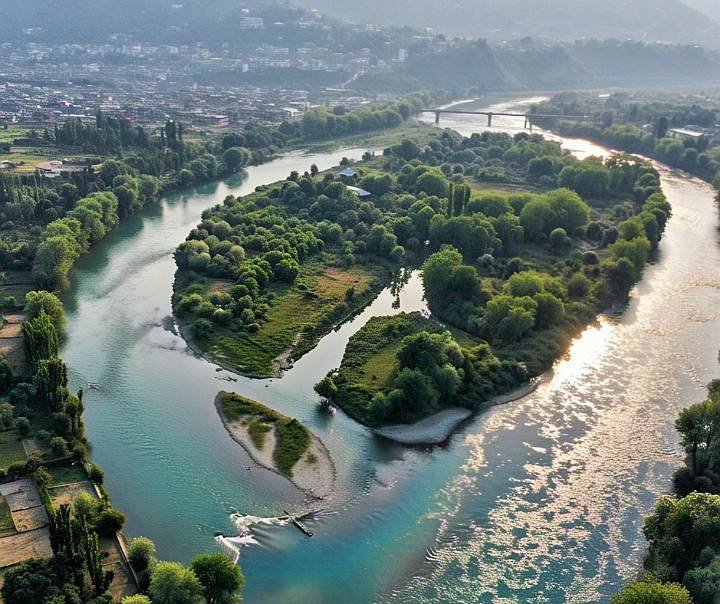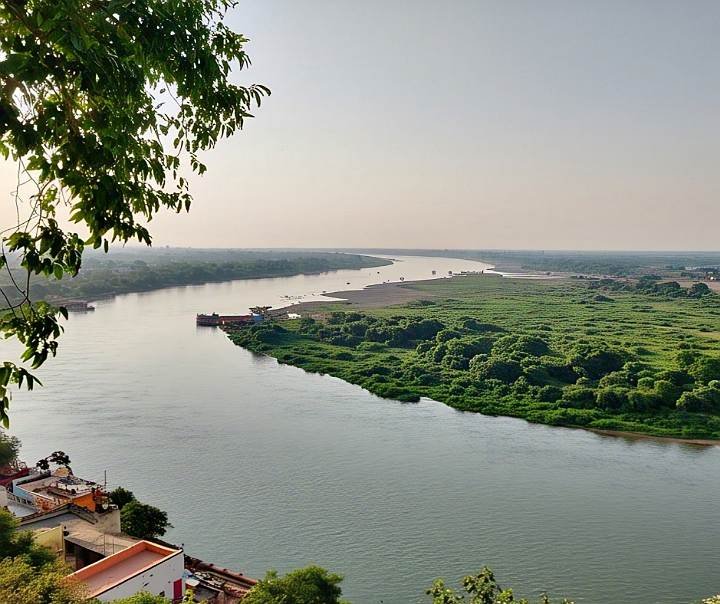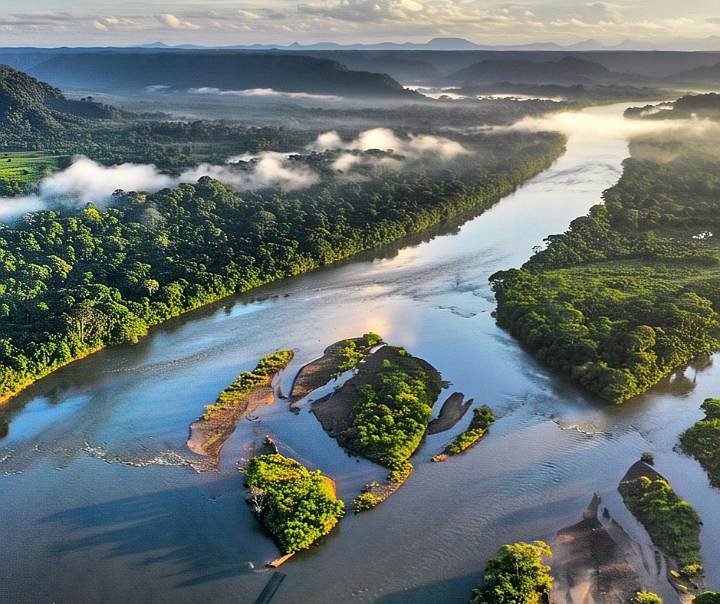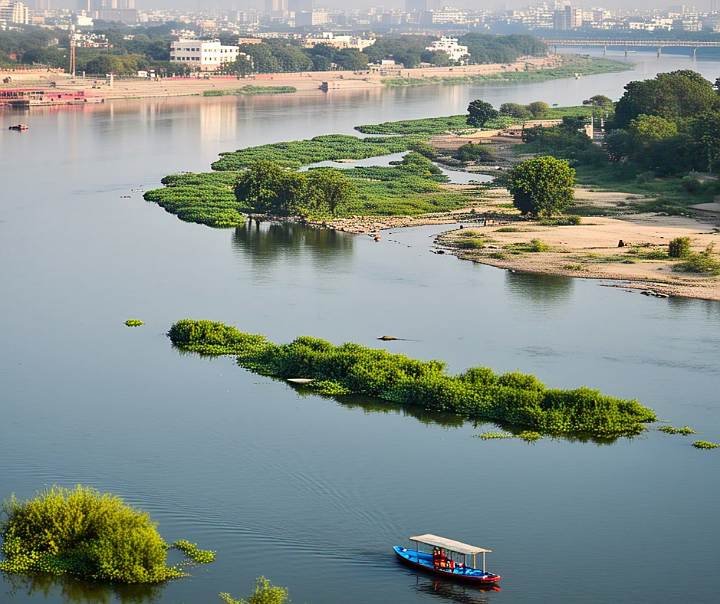The Ganga River : A Journey from the Himalayas to the Sea
The Ganga River, revered as Mother Ganga in India, is more than just a river—it is the lifeline of Indian culture, spirituality, and economy. Stretching over 2,525 kilometers from the icy peaks of the Himalayas to the Bay of Bengal, the Ganga is a symbol of purity and sustenance. In this detailed blog post, we will explore the Ganga’s journey from its origin to its merger with the sea, its religious, cultural, economic, and environmental significance, and the vital role played by its tributaries.
1. The Origin of the Ganga River : Birth in the Himalayas
The Ganga River originates in the Gangotri Glacier at Gomukh, located in Uttarkashi district, Uttarakhand, at an altitude of about 3,892 meters above sea level. Gomukh, meaning “cow’s mouth,” is where the glacier’s ice melts to form the Bhagirathi River, considered the primary source of the Ganga in Hindu tradition. The Bhagirathi is named after King Bhagirath, whose penance, according to mythology, brought Ganga from heaven to Earth to redeem his ancestors.
Flowing swiftly from Gomukh, the Bhagirathi gathers water from smaller streams and rivulets. Meanwhile, the Alaknanda River, another major source of the Ganga, originates from the Satopanth and Bhagirath Kharak Glaciers near Badrinath. Although the Alaknanda is longer than the Bhagirathi, the latter holds greater religious significance as the Ganga’s source.

The Bhagirathi and Alaknanda meet at Devprayag, a sacred confluence in Uttarakhand, where the river officially becomes the Ganga. This confluence is one of the five sacred confluences (Panch Prayag) in the region, revered by Hindus.
Learn more about the Gangotri Glacier on Wikipedia.
2. The Journey of the Ganga River : From Mountains to the Sea
The Ganga’s journey can be divided into three distinct phases: the Himalayan region, the plains, and the delta region. Along this journey, the Ganga is joined by numerous tributaries that significantly enhance its flow and importance.
2.1 Himalayan Region
From Devprayag, the Ganga flows through the rugged Himalayan terrain, carving deep valleys and gorges. The river’s waters are swift and relatively clean in this region, as human activity is minimal. Key towns like Rishikesh and Haridwar mark important stops along this stretch. In Haridwar, the Ganga enters the plains for the first time, becoming a major pilgrimage site. The Ganga Aarti at Har ki Pauri in Haridwar is a mesmerizing ritual, drawing thousands of devotees daily.
2.2 Plains Region
After Haridwar, the Ganga flows through the vast Gangetic Plains, one of the most fertile and densely populated regions in the world. The river passes through states like Uttar Pradesh, Bihar, and West Bengal, nourishing millions of people. This is where the Ganga is joined by its major tributaries, which we will explore in detail later. Cities like Kanpur, Prayagraj, Varanasi, Patna, and Bhagalpur thrive along its banks, each adding to the river’s cultural and economic significance.
2.3 Delta Region
In West Bengal, the Ganga splits into two main distributaries: the Padma and the Hooghly. The Padma flows into Bangladesh, where it joins the Brahmaputra and Meghna rivers to form the Sundarbans Delta, the world’s largest river delta, spanning about 60,000 square kilometers. The Hooghly flows past Kolkata and merges with the Bay of Bengal. The Sundarbans, a UNESCO World Heritage Site, is home to the Royal Bengal Tiger, Ganga River Dolphin, and diverse ecosystems.
Explore the Sundarbans Delta on UNESCO’s official website.
3. The Tributaries of the Ganga: Lifelines of the River
The Ganga’s grandeur is largely due to its extensive network of tributaries, which contribute significantly to its water volume, ecological diversity, and cultural importance. The Ganga River Basin, covering about 1.08 million square kilometers, is fed by numerous rivers originating in the Himalayas, the Central Highlands, and Nepal. Below, we explore the major tributaries in detail, highlighting their origins, paths, and contributions to the Ganga.
3.1 Yamuna River
- Origin: The Yamuna, the largest tributary of the Ganga, originates from the Yamunotri Glacier in Uttarkashi, Uttarakhand, at an altitude of about 6,387 meters.
- Path: Flowing through Uttarakhand, Himachal Pradesh, Haryana, Delhi, and Uttar Pradesh, the Yamuna covers approximately 1,376 kilometers before joining the Ganga at Prayagraj (Allahabad). This confluence, known as the Sangam, is one of the holiest sites in Hinduism, where the mythical Saraswati River is believed to join the two rivers underground.
- Tributaries of Yamuna: The Yamuna is fed by rivers like the Tons, Chambal, Betwa, and Ken, which further enhance its flow.
- Significance: The Yamuna irrigates vast agricultural lands in the Gangetic Plains and supports cities like Delhi and Agra. However, it is heavily polluted due to industrial and domestic waste, especially in Delhi.
- Cultural Importance: The Yamuna is revered as a goddess in Hinduism, and festivals like Yamuna Chhath are celebrated along its banks.
3.2 Ghaghara River
- Origin: The Ghaghara, also known as the Karnali in Nepal, originates from the Mapchachungo Glacier near Lake Manasarovar in Tibet, at an elevation of about 4,800 meters.
- Path: Flowing through Nepal and Uttar Pradesh, the Ghaghara covers about 1,080 kilometers before joining the Ganga near Chhapra in Bihar. It is the largest tributary by water volume.
- Tributaries: The Ghaghara is joined by rivers like the Sarda (Mahakali), Rapti, and Little Gandak.
- Significance: The Ghaghara is vital for irrigation and agriculture in Uttar Pradesh and Bihar. However, it is prone to flooding, causing significant damage during monsoons.
- Cultural Importance: The Ghaghara’s banks are dotted with ancient temples and ghats, and it plays a role in local festivals and rituals.
3.3 Kosi River
- Origin: The Kosi, often called the “Sorrow of Bihar” due to its frequent flooding, originates in the Himalayas near Mount Everest in Tibet and Nepal.
- Path: Flowing through Nepal and Bihar, the Kosi covers about 729 kilometers before merging with the Ganga near Kursela in Bihar.
- Tributaries: The Kosi is formed by seven streams, including the Arun, Sun Kosi, and Tamor, earning it the name Saptakoshi (seven rivers).
- Significance: The Kosi’s fertile silt supports agriculture, but its unpredictable course and floods have displaced millions. The Kosi Barrage was built to control its flow.
- Cultural Importance: Despite its destructive nature, the Kosi is revered in local folklore and is associated with Goddess Kosi in some traditions.
3.4 Gandak River
- Origin: The Gandak, also known as the Narayani in Nepal, originates from the Nhubine Himal Glacier in Nepal, near the Nepal-Tibet border.
- Path: Flowing through Nepal and Bihar, the Gandak covers about 630 kilometers before joining the Ganga near Patna.
- Tributaries: The Gandak is fed by rivers like the Trisuli and Budhi Gandak.
- Significance: The Gandak supports irrigation and hydropower projects, such as the Gandak Barrage. Its waters are crucial for Bihar’s agriculture.
- Cultural Importance: The Gandak’s confluence with the Ganga is a pilgrimage site, and its banks host several religious fairs.
3.5 Son River
- Origin: The Son, one of the largest southern tributaries, originates in the Amarkantak Plateau in Madhya Pradesh, at an elevation of about 600 meters.
- Path: Flowing through Madhya Pradesh, Uttar Pradesh, and Bihar, the Son covers about 784 kilometers before joining the Ganga near Patna.
- Tributaries: The Son is fed by rivers like the Johilla and Rihand.
- Significance: The Son’s red-colored waters, due to iron-rich soil, are used for irrigation and sand mining. The river supports agriculture and industries in central India.
- Cultural Importance: The Son is mentioned in ancient texts like the Ramayana and is considered sacred by local communities.
3.6 Other Notable Tributaries
- Ramganga: Originating in the Kumaon Himalayas, it joins the Ganga near Kannauj, Uttar Pradesh, supporting irrigation and hydropower.
- Gomti: Flowing through Lucknow, it joins the Ganga near Varanasi, contributing to urban water supply and agriculture.
- Tons: A major tributary of the Yamuna, it indirectly feeds the Ganga through the Sangam.
- Mahananda: Joining the Ganga in West Bengal, it supports agriculture and fisheries in the region.
These tributaries collectively make the Ganga one of the most voluminous rivers in the world, sustaining millions of lives and shaping the Gangetic Plains’ ecology and economy.
For a detailed overview of the Ganga’s tributaries, visit Britannica.
4. Religious and Cultural Significance of the Ganga
The Ganga is the holiest river in Hinduism, worshipped as Mother Ganga. According to mythology, Ganga descended from heaven to Earth due to King Bhagirath’s penance, with Lord Shiva controlling her fierce flow by trapping her in his matted locks.
4.1 Religious Importance
- Cleansing Sins: Hindus believe that bathing in the Ganga washes away sins. Millions visit its ghats for spiritual purification.
- Moksha (Salvation): Performing last rites or immersing ashes in the Ganga is believed to grant moksha (liberation). Varanasi’s Manikarnika Ghat is famous for cremations.
- Kumbh Mela: Held every 12 years in Prayagraj, Haridwar, Ujjain, and Nashik, the Kumbh Mela attracts millions for Ganga snan (holy dip).
4.2 Cultural Importance
The Ganga has inspired poets, writers, and artists for centuries. Jawaharlal Nehru wrote in Discovery of India, “The story of the Ganga is the story of India’s civilization.” Cities like Varanasi, Haridwar, and Prayagraj are cultural hubs, hosting festivals, rituals, and the iconic Ganga Aarti. The river’s banks are lined with ancient temples, ashrams, and ghats, reflecting India’s rich heritage.
Learn about the Kumbh Mela on its official website.
5. Economic Importance of the Ganga
The Ganga Basin supports nearly 650 million people, making it the world’s most populous river basin. Its economic contributions are immense:
5.1 Agriculture
The Ganga and its tributaries irrigate the fertile Gangetic Plains, supporting crops like rice, wheat, sugarcane, and pulses. Canals and barrages, such as the Farakka Barrage and Upper Ganga Canal, distribute water for farming.
5.2 Fisheries
The Ganga and its tributaries host about 140 fish species, providing livelihoods for fishermen. Tributaries like the Kosi and Mahananda are particularly rich in fisheries.
5.3 Industry
Industrial cities like Kanpur, Kolkata, and Patna rely on the Ganga and its tributaries for water. However, industrial waste is a major pollutant.
5.4 Tourism
The Ganga’s tributaries, especially the Yamuna and Ghaghara, attract tourists to sites like the Taj Mahal (on the Yamuna) and religious fairs. Rishikesh’s river rafting and Varanasi’s ghats are major draws.
6. Biodiversity of the Ganga and Its Tributaries
The Ganga Basin is a hotspot of biodiversity, with its tributaries playing a critical role in supporting ecosystems.
- Ganga River Dolphin: India’s national aquatic animal, found in the Ganga and tributaries like the Ghaghara and Kosi, is endangered due to pollution.
- Gharial: A rare crocodile species inhabits the Ganga and tributaries like the Son and Gandak.
- Turtles: Several turtle species thrive in the Ganga and Yamuna, aiding ecological balance.
- Birds: Tributaries like the Mahananda and Kosi attract migratory birds, including Siberian cranes.
Learn about the Ganga River Dolphin on WWF India.
7. Challenges Facing the Ganga: Pollution and Conservation
The Ganga and its tributaries face severe challenges, primarily due to pollution.
7.1 Causes of Pollution
- Domestic Waste: Cities along the Ganga and tributaries like the Yamuna discharge billions of liters of sewage daily.
- Industrial Pollution: Factories in Kanpur and Delhi release toxic chemicals into the Ganga and Yamuna.
- Agricultural Runoff: Pesticides and fertilizers from fields along the Kosi and Son pollute the rivers.
- Religious Activities: Offerings like flowers and idols contribute to pollution.
7.2 Conservation Efforts
- Ganga Action Plan (1986): An early attempt to clean the Ganga, it failed due to mismanagement.
- Namami Gange Programme (2014): A flagship initiative with over ₹20,000 crore allocated for sewage treatment, river cleaning, and biodiversity conservation.
- Barrages and Canals: Structures like the Farakka Barrage regulate water flow but impact ecology.
Despite these efforts, progress is slow. Community participation and stricter regulations are needed.
Explore the Namami Gange Programme on its official website.
8. The Future of the Ganga
The Ganga and its tributaries are vital to India’s survival. To ensure their health, we need:
- Awareness Campaigns: Educating people about the rivers’ importance.
- Technology: Using bioremediation and advanced sewage treatment.
- Community Involvement: Engaging locals in conservation efforts.
- Legal Action: Enforcing strict penalties for polluters.
9. Conclusion
The Ganga River, with its vast network of tributaries like the Yamuna, Ghaghara, Kosi, Gandak, and Son, is India’s lifeline. It sustains millions, nurtures spirituality, and drives the economy. However, pollution threatens its existence. By understanding the Ganga’s journey and the role of its tributaries, we can work together to restore its glory for future generations.
- Jhelum River : From Verinag to Arabian Sea Detailed Description
- For more on the Ganga, visit National Geographic.




